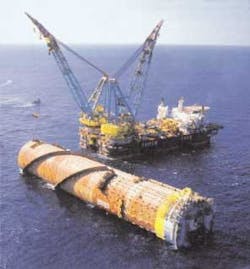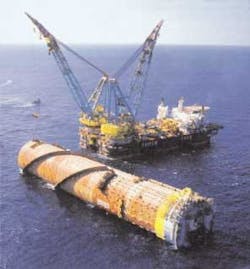Demands on heavy lift vessels increase with water depth
More than just a landmark installation
Frank Hartley
Drilling/Production Editor
As the offshore industry evolves to keep pace with the demands of deepwater field developments, many opportunities and challenges lie ahead for heavy lift vessels. Adding the world's largest J-lay tower, capable of laying pipe of 4-in. to 32-in. diameter, converted the Saipem 7000 semisub-mersible crane vessel to a combination derrick and pipe laying heavy lift vessel (HLV). The DP Class III system was upgraded by increasing the number of thrusters from 10 to 12, providing a combined 831 tons of thrust. Fitting a new underwater block to the port crane provided a 59-ton lifting capacity at 5,430-ft water depth. Plus, two ROVs were added as a permanent feature on the vessel.
Deepwater development
The ExxonMobil Hoover Diana development in the Gulf of Mexico proved to be more than just a landmark installation. It presented many challenges to the offshore construction industry. The major facility in this development was the moored production system in the form of a deep draft caisson vessel (DDCV), which supports about 22,000 tons of drilling and production topsides. The S7000 was contracted to:
- Install 12 suction piles and mooring lines
- Connection of DDCV to mooring system
- Install topsides - lower deck at 8,420 tons; upper deck at 8,790 tons
- Support hook-up
- Install two 15-km lengths of 10-in. flowlines
- Install one 15-km lengths of 6-in. flowline
- Install two 10-in. steel catenary risers (SCRs)
- Install two 18-in. SCRs
- Install one 6-in. SCR.
Mooring installation
The ROV spread of 12 suction piles and the new generation vehicles provided mooring lines from Oceaneering (Millennium) and Sonsub (Innovator). The water depth at the location was 4,850 ft.
A wire deployment winch of 220-ton line pull was built to handle the 6 1/2 in. coated wire. The winch drum was split into two bays, each capable of storing one complete segment of wire. The core diameter of the winch was such that the bearing pressures on the spiral-coated wire were maintained below 3,000 psi.
An over-boarding caterpillar was mounted at the bow of the HLV to provide maximum protection to the wire coating during the crucial over-boarding stage, with the wire under tension. Again, the bearing pressure on the coated wire was maintained below 3,000 psi.
A hydraulically-released spreader bar was also supplied for the pile deployment. The large deck area of the HLV facilitated pre-loading of the majority of the mooring systems components, thereby minimizing the transfer of components offshore.
The Diana suction piles had an aspect ratio >2 and represented a record in terms of diameter, length, and weight for this type of pile. Two cranes lifted and rotated each pile to the vertical. One crane lowered each pile to the seabed with the first section of chain and wire attached. The target position of each pile was identified via a transponder array, while the Millennium and Innovator ROVs monitored the lowering and positioning operations.
An accurate surface positioning system is mandatory, particularly in areas where loop and eddy currents prevail. Penetration of the pile into the seabed was achieved via a dedicated suction pump skid docked onto the pile, which contained a north seeking grid, echo sounder, x-y inclinometers and differential pressure gauges.
Once the target penetration was reached, the hydraulically activated release system removed the pump skid and disengaged the pile handling facilities. The HLV was maneuvered along the laydown corridor, laying out the first segment of spiral wire, prior to connection of the second chain segment.
The complete mooring leg was laid out on the seabed to prevent entanglement during recovery and subsequent connection to the DDCV. The ROV Innovator, with tether excursion of 2,700 ft eliminating the need for a survey vessel, performed touchdown monitoring of the mooring leg.
A receptacle frame was attached to the abandoned end of the chain to facilitate engagement of the recovery tool. Each leg was installed in a similar manner and laid out on the seabed in a "candy cane" configuration.
The upending of large diameter piles by twin cranes proved to be an efficient and safe operation and protected the pile from deformation that might impair the suction operation. Additionally, the investment in wire handling equipment and adopted procedures resulted in only six coating repairs in 15 mi of installed wire.
null
Mooring connections
The DDCV was "wet-towed" to site from the assembly area at Aker Gulf Marine's yard in Corpus Christi, Texas. Having received a favorable weather forecast, the DDCV was ballasted to 5° trim by a pump boat. Rip-out diaphragms in the hull mid-section were then pulled and the tow spread disconnected. The soft tank rip-out diaphragms were subsequently pulled to permit self-upending of the DDCV to 78° trim. The DDCV was ballasted to vertical via the pump boat.
The DDCV was brought to the center of the mooring array and restrained in position by four tugs. The HLV then set a chain locker and a temporary work deck onto the DDCV to facilitate connection to the mooring lines.
The temporary work deck was about 1,000 tons and incorporated two chain windlasses, which could be positioned in line with individual DDCV chain jack slots. The deck also was fitted with two cranes, one of 100-ton capacity for general load transfer and one of 80-ton capacity for the handling of a messenger chain provided on the temporary work deck to facilitate individual connection of each mooring line to the hull.
The HLV maneuvered to the UTM position of the abandoned chain end of the first mooring line to be connected. The chain was recovered to the deck via crane and the recovery receptacle removed. The HLV was positioned 750 ft from the DDCV and passed a recovery wire to a tug to connect to the messenger chain on the DDCV.
The HLV hauled in the messenger wire and chain by winch and connected the messenger chain to the recovered mooring chain. A crane then lifted the messenger chain and platform chain at their connection and held them overboard. The HLV winch tensioned the recovery wire to provide equilibrium. The chain was lowered into the water till the recovery wire tension and hook load were minimal.
The chain jack and the mooring connection released the system so that the messenger chain and eventually the platform chain could be pulled into the DDCV. This procedure was repeated for the remaining 11 mooring lines.
With the DDCV now tethered, the final operation was to add 23,500 tons of solid ballast via a bunkering barge moored to the side of the HLV. The temporary work was removed, and the DDCV prepared for the setting of the large integrated decks.
Topside installation
The HLV was positioned into a good heading for tandem lifting from the cargo barge. The S44 barge was brought to the bow of the HLV where sea fastenings were cut, the lower deck lifted, and the cargo barge removed. The HLV was maneuvered to the DDCV to set the decks.
The lifting, positioning, and setting of very large decks on floating structures in a dynamic positioning (DP) mode is a sophisticated operation. It involves detailed study of interactive first and second order effects. It also requires careful preparation, skill, and experience in operation of cranes, ballast, and DP systems during execution.
The second load transfer operation of the upper deck with a lift weight of 8,790 tons was the largest deck to be set offshore onto a floating structure. The HLV completed the remaining minor lifts and remained at the DDCV for three weeks to support hook-up.
null
Pipe handling
The installation of flowlines, particularly on large fields in deep or ultra deepwater handling large-diameter pipe in DP mode, is an area for which the upgraded HLV with its J-lay system and improved DP system was specifically designed. It has operated as a DP semisubmersible crane vessel during most of the 1990s. The HLV J-lay system involves several complex sub-systems designed to safely perform the following operations in sequence, on each quad-joint:
- Transfer from quad-joint rack for holiday detection
- Bevel and forward transfer to the elevator system
- Upend to vertical and elevate to the upper tower
- Insert the line-up tool into the quad-joint
- Lower and align the quad-joint with the preceding (welded) quad-joint
- Weld and visually inspect quad-joint to the preceding joint
- Clamp and lower the welded quad-joint
- Perform non-destructive testing and coat the welded "field joint."
Normally, these activities determine the so-called "cycle time" of the pipelay production process and, consequently, the productivity. This is clearly the case, assuming that all other steps – transfer, upending, rotation, and lowering, etc. – are done in non-critical time on each subsequent quad-joint.
All pipe-handling activities, plus the welding and non-destructive testing, are performed in either an automatic or semi-automatic manner. In addition, the quad-joint, when welded into the pipeline string, becomes extremely heavy.
The HLV J-lay system is an impressive "heavy industrial marine factory" in which quad-joint handling is automatic, with no involvement of the main cranes other than loading of the quad-joints in their containers onto the vessel.
While the J-lay activities on the HLV are sophisticated, there is an added level of expertise associated with monitoring of the so- called "touchdown" point of the pipe as it is laid on the seabed. The ultra-deepwater ROVs are employed when the touchdown point of the pipe is several hundreds of meters from the vessel.
SCR installation
During the installation of SCRs, the HLV is at its most valuable when in pipelay mode. The main cranes safely transfer the SCR to the floating facility. For this activity, all the core competencies of the HLV are used: cranes, pipelay, DP, and underwater intervention. These are the most challenging in offshore deepwater because the two floating units are close to one another and because the SCRs are among the most delicate components of the complete facility.
The completion of the installation established the following:
- The highest standards of safety are achievable. During the offshore operations, within the HLV scope of work, 792,024 offshore work-hours were expended with zero lost time incidents or recordable injuries
- A major construction vessel with HLV station-keeping capability can operate year-round in the GoM with minimal weather downtime
- A powerful and reliable dynamic-positioning system is mandatory for high accuracy operations in areas where loop and eddy currents prevail
- The ability of a lift or pipelaying vessel to work with minimal cargo barges offshore will dramatically reduce weather downtime.


